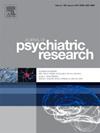Longitudinal causal dynamics between perceived burdensomeness and suicidal ideation: Population-based cohort study
IF 3.7
2区 医学
Q1 PSYCHIATRY
引用次数: 0
Abstract
Better understanding of the determinants of suicidal distress may be critical to improving clinical approaches to suicide prevention. According to the Interpersonal-Psychological Theory of Suicide, perceived burdensomeness (PB) is one of the proximal, causal risk factors for the development of suicidal distress. Considerable cross-sectional data has supported this association, but limited longitudinal data has investigated whether short-term change in PB influences subsequent suicidal ideation (SI). This longitudinal study involved daily assessments of both PB and SI over a 7-day period in 791 Australian adults who reported recent or current SI. Eight different panel models, with and without covariates were fit to examine cross-lagged effects between PB and SI. In the final model, there was weak evidence for a lagged effect from PB on SI the next day (β = 0.175), although the contemporaneous effect of PB on SI was larger and more consistent (β = 0.948). There was little evidence for lagged effects of SI on PB (β = 0.008). Effects varied across age groups and living situations. Inconsistent with the theory, findings suggest limited value of PB in predicting later SI, after accounting for cross-sectional relationships. Greater consideration of other psychosocial and contextual risk factors may be important for theories of suicide risk and for supporting people who are at risk of suicidal behaviour.
感知负担与自杀意念之间的纵向因果动态关系:基于人群的队列研究
更好地了解自杀困扰的决定因素可能对改善自杀预防的临床方法至关重要。根据自杀的人际心理理论,感知负担(perceived burden, PB)是自杀困扰发生的近因性危险因素之一。大量的横断面数据支持这一关联,但有限的纵向数据调查了短期的PB变化是否会影响随后的自杀意念(SI)。这项纵向研究对791名最近或目前患有SI的澳大利亚成年人进行了为期7天的PB和SI每日评估。8个不同的面板模型,有或没有协变量,适合检验交叉滞后效应之间的PB和SI。在最后的模型中,尽管PB对SI的同期效应更大且更一致(β = 0.948),但PB对第二天SI的滞后效应(β = 0.175)的证据很弱。SI对PB的滞后效应不明显(β = 0.008)。影响因年龄组和生活环境而异。与理论不一致的是,研究结果表明,在考虑了横截面关系后,PB在预测后来的SI方面的价值有限。更多地考虑其他社会心理和环境风险因素可能对自杀风险理论和支持有自杀行为风险的人很重要。
本文章由计算机程序翻译,如有差异,请以英文原文为准。
求助全文
约1分钟内获得全文
求助全文
来源期刊

Journal of psychiatric research
医学-精神病学
CiteScore
7.30
自引率
2.10%
发文量
622
审稿时长
130 days
期刊介绍:
Founded in 1961 to report on the latest work in psychiatry and cognate disciplines, the Journal of Psychiatric Research is dedicated to innovative and timely studies of four important areas of research:
(1) clinical studies of all disciplines relating to psychiatric illness, as well as normal human behaviour, including biochemical, physiological, genetic, environmental, social, psychological and epidemiological factors;
(2) basic studies pertaining to psychiatry in such fields as neuropsychopharmacology, neuroendocrinology, electrophysiology, genetics, experimental psychology and epidemiology;
(3) the growing application of clinical laboratory techniques in psychiatry, including imagery and spectroscopy of the brain, molecular biology and computer sciences;
 求助内容:
求助内容: 应助结果提醒方式:
应助结果提醒方式:


